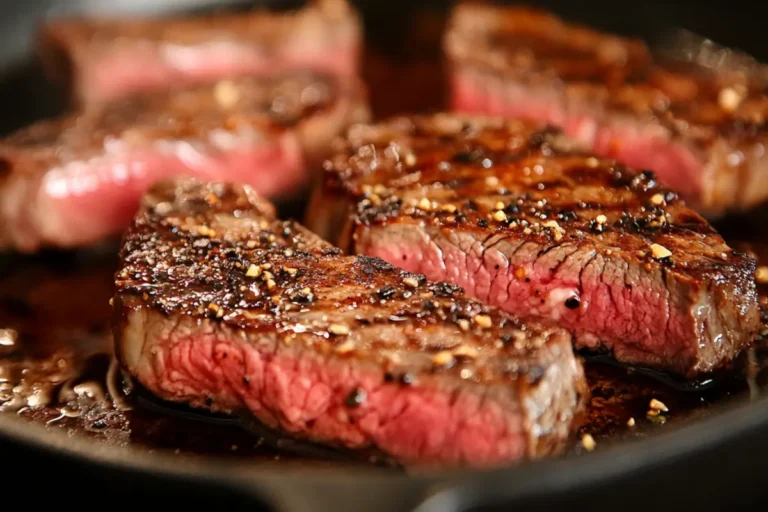Steak Temperatures
How to Cook the Perfect Steak Every Time
Cooking steak to the right temperature is essential for the best flavor and texture. Whether you love your steak rare, medium-rare, or well-done, knowing the correct temperatures will help you get it just right every time. This guide breaks down steak doneness levels, how to achieve them, and expert tips for perfecting your steak. You’ll also find internal links to relevant recipes like Chicken Parmigiana and Cottage Cheese Recipes that pair beautifully with steak.
Understanding Steak Temperatures
The internal temperature of a steak determines its doneness. Here’s a quick look at the different levels of doneness and how they affect flavor and texture:
Rare (120-125°F / 49-52°C)
- Look: Bright red in the center, slightly warm.
- Texture: Soft, tender, and juicy.
- Best for: Those who enjoy the pure taste of beef with minimal cooking.
Medium-Rare (130-135°F / 54-57°C)
- Look: Warm red center with a slight pink ring.
- Texture: Juicy, tender, and a bit firmer than rare.
- Best for: The most popular doneness, providing a great balance between flavor and tenderness.
If you love medium-rare steak, learn how to cook it perfectly with this How to Cook Medium-Rare Steak guide.
Medium (140-145°F / 60-63°C)
- Look: Pink in the center with some brown edges.
- Texture: Juicy but firmer than medium-rare.
- Best for: People who like a little more cooked texture but still want some pink inside.
Medium-Well (150-155°F / 65-68°C)
- Look: Slight pink in the middle with mostly brown around the edges.
- Texture: Firm with little juice left.
- Best for: Those who prefer their steak mostly cooked but with a hint of moisture.
Well-Done (160°F+ / 71°C+)
- Look: Brown throughout with no pink.
- Texture: Very firm and dry.
- Best for: People who like their steak fully cooked with no moisture or pink.
Tips for Measuring Steak Temperature
The most accurate way to check your steak’s doneness is by using a meat thermometer. Here’s how to do it correctly:
- Insert the thermometer into the thickest part of the steak, avoiding bones or fat.
- Wait until the temperature stabilizes to ensure accuracy.
Using a thermometer ensures that your steak reaches the exact doneness you prefer. For more cooking tips, see our guide on How to Cook Steak on the Stovetop.
How to Cook Steak to Different Temperatures
Follow these steps to cook your steak to your desired doneness:
Rare Steak
- Preheat a cast-iron skillet over high heat for 5 minutes.
- Season the steak with salt and pepper.
- Sear for 2 minutes per side, checking that the internal temperature is 120-125°F.
- Let the steak rest for 5 minutes before serving.
Medium-Rare Steak
- Follow the same steps as above but sear for 3 minutes per side.
- Make sure the internal temperature is 130-135°F before resting.
Serve your medium-rare steak with a hearty side like Ultimate Squash Casserole for a complete meal.
Medium Steak
- Sear each side for 4 minutes.
- The internal temperature should be 140-145°F.
Medium-Well Steak
- Sear for 5 minutes per side.
- Check the temperature to make sure it hits 150-155°F.
Well-Done Steak
- Sear for 6 minutes per side.
- The internal temperature should reach 160°F or more.
Basting the steak with butter during the cooking process helps retain moisture, especially for well-done steaks.
Why Resting Steak Matters
Resting your steak after cooking is key to keeping it juicy and tender. When steak cooks, the juices are pulled toward the surface. Letting it rest for 5-10 minutes before cutting allows the juices to redistribute throughout the meat. This prevents the steak from becoming dry when you slice into it.
Common Steak-Cooking Mistakes
1. Not Using a Meat Thermometer
Using a thermometer ensures your steak is cooked exactly to your liking without overcooking or undercooking.
2. Skipping the Resting Step
Resting is essential to keeping the juices in the steak. Cutting too soon will make the steak dry.
3. Overcooking the Steak
Remove the steak from heat as soon as it reaches your desired temperature. Overcooking leads to dryness and a tough texture.
4. Not Preheating the Pan or Grill
A properly preheated surface is necessary for getting a good sear, which locks in flavor and juices.
Different Methods to Cook Steak
Here’s a look at different ways to cook your steak to the perfect doneness:
Stovetop
Using a cast-iron skillet on the stovetop creates a great sear. You can finish thicker steaks in the oven for even cooking.
Grilling
Grilling imparts a smoky flavor while creating a crisp exterior. Preheat your grill and oil the grates to prevent sticking.
Sous Vide
Sous vide cooking ensures precise doneness. After cooking in a sous vide water bath, sear the steak in a hot pan for a crispy crust.
Nutritional Benefits of Steak at Different Temperatures
Steak provides essential nutrients no matter how it’s cooked, but lower temperatures help retain more vitamins and minerals. For instance, rare and medium-rare steaks retain more B12, iron, and zinc. Even well-done steak still offers a healthy source of protein.
FAQs About Steak Temperatures
1. What is the best temperature for steak?
- The most popular temperature for steak is medium-rare (130-135°F). It offers a balance of tenderness, juiciness, and flavor, with a warm red center. However, the “best” temperature depends on personal preference, with some preferring rare or well-done.
2. How do I tell if my steak is done without a meat thermometer?
- You can use the finger test to estimate doneness:
- Rare: Feels like the soft part of your palm under your thumb when your hand is relaxed.
- Medium-rare: Feels like the base of your thumb when your hand is relaxed.
- Medium: Feels like the firmness of your palm when you press your middle finger and thumb together.
- Well-done: Feels firm, like the base of your thumb when your hand is in a fist.
3. Should I cook steak straight from the fridge?
- No, it’s best to let your steak come to room temperature for about 30-45 minutes before cooking. This ensures even cooking throughout the steak, preventing the outside from overcooking while the inside remains undercooked.
4. How long should I rest the steak after cooking?
- After cooking, let your steak rest for 5-10 minutes. Resting allows the juices to redistribute throughout the meat, keeping it juicy and flavorful when sliced.
5. Is it safe to eat steak rare?
- Yes, eating rare steak is safe as long as it’s been properly handled and cooked. The searing process on the outside kills surface bacteria. However, steak tartare, which is raw, should be prepared with high-quality, fresh beef and handled carefully to minimize risks.
6. What is the difference between medium and medium-rare steak?
- Medium-rare steak is cooked to 130-135°F, with a warm red center and a pink band around it. It’s juicy and tender, with more moisture than medium.
- Medium steak is cooked to 140-145°F, with a pink center. It’s still juicy, but slightly firmer than medium-rare, with less pink inside.
7. Can you refreeze steak after thawing?
- Yes, you can refreeze steak if it has been thawed in the refrigerator. However, refreezing can affect the texture and quality of the meat. It’s better to cook the steak after thawing and then freeze the cooked leftovers.
8. What’s the best oil to use when searing steak?
- Use oils with a high smoke point, such as avocado oil, grapeseed oil, or canola oil. These oils can handle the high temperatures needed for searing without burning, allowing the steak to develop a proper crust.
9. How long should I cook steak on each side for medium-rare?
- For a 1-inch thick steak:
- Stovetop: Sear for 3-4 minutes per side over medium-high heat.
- Grill: Grill for 3-4 minutes per side over high heat.
- Oven: After searing, finish in a 400°F oven for 5-8 minutes, depending on thickness. Always check with a meat thermometer to ensure the steak reaches 130-135°F for medium-rare.
10. Does the thickness of the steak affect the cooking time?
- Yes, thicker steaks take longer to cook, especially when trying to achieve a specific doneness. For example, a 2-inch thick steak will need more time than a 1-inch steak to reach medium-rare. Thicker cuts may also benefit from being finished in the oven after searing to cook evenly without burning the outside.
11. Can I cook steak in the oven without searing it?
- While you can cook steak entirely in the oven, searing first provides a flavorful crust that enhances the taste and texture. If you skip the sear, the steak may not develop the same rich, caramelized exterior. However, using the broiler function in the oven can create a similar effect.
12. How do I keep my steak from drying out when cooking well-done?
- To prevent a well-done steak from drying out, you can:
- Baste the steak with butter or oil during cooking.
- Sear on high heat to lock in moisture, then finish on lower heat to cook through.
- Use cuts with higher fat content, such as ribeye, to retain more juiciness even when cooked well-done.
13. Why does my steak taste tough?
- Steak can become tough if it’s overcooked, which dries out the meat and tightens the muscle fibers. Undercooked steak can also be tough, especially in leaner cuts like sirloin. Using a meat thermometer helps avoid this problem, ensuring the steak is cooked to your desired doneness.
14. What are the best cuts for cooking steak at different temperatures?
- For rare to medium-rare: Cuts with more marbling, like ribeye and filet mignon, work best because they stay tender and juicy even with minimal cooking.
- For medium to well-done: Leaner cuts, like sirloin or strip steak, are better choices, as they maintain flavor and texture even when cooked longer.

